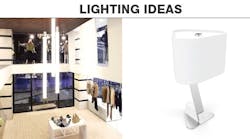The 2016 iteration of Title 24, California’s building energy efficiency standards, takes effect at the beginning of next year, and as Golden State FMs likely already know, it imposes a host of new requirements on any building undergoing renovations or remodeling.
Residential buildings bore the brunt of the energy reductions this year with a requirement to become net-zero-ready, with non-residential facilities likely to follow in the 2019 iteration of Title 24, says Rick Miller, President of RNM Engineering in San Luis Obispo, CA. However, it may make financial sense to begin renovating to the 2016 standards now with an eye toward getting ready for stricter rules in 2019. Facilities managers outside California would also do well to pay attention to Title 24, as the energy mandate could spread to other states.
Can your building comply with these four code updates?
1) Lighting Power Density Allowances
One of the most consequential changes to the code involves reductions to the allowed lighting power density (LPD) for two of the three strategies that owners can use to calculate indoor lighting power. The complete building method covers the entire facility and assigns allowed lighting power density by building type; many retain the same LPD assigned in the 2013 version, but some (including auditoriums, convention centers and libraries) lost 0.1-0.2 watts per square foot.
The area category method, on the other hand, provides separate lighting power allotments for different space types. For example, an auditorium likely has specialty lighting that requires a larger power draw than a simple corridor, which is why auditorium areas are allowed to use up to 1.4 watts per square foot (a reduction of 0.1 watts from 2013), while corridors are only allowed to use 0.6 watts per square foot. Most changes in the category method were reductions of 0.2 watts per square foot or less, but FMs planning to remodel lobby areas will notice a significant change – main entry lobbies for non-hotel buildings are restricted to 0.95 watts per square foot in lobbies, a 37% reduction from the 1.5 watts permitted in 2013.
The new code also makes significant changes to outdoor lighting requirements. ATMs, tunnels and bridges are no longer exempt from lighting power allowance calculations, so facilities professionals who have these on their campuses will have to account for these in any future projects affecting outdoor lighting. Power allowances for hardscape zones – parking lots, driveways, sidewalks, and other paved areas – were reduced in nearly every category, usually by at least one-third and in some cases by more than half.
The code also creates a new Lighting Zone 0, used for undeveloped areas of government-designated parks, recreation areas, and wildlife preserves. Continuous lighting is prohibited in this zone.
2) Lighting Controls
Tweaks to the requirements for lighting controls were intended to make the code easier to understand, says Philip Hall, Director of Lighting Control Systems and Code Compliance Programs for Enlighted, a lighting control manufacturer based in Sunnyvale, CA.
“A few things are simpler, but there are still areas that don’t entirely make sense,” Hall says. “You may need to call the Title 24 hotline for verification on some contradictions. For example, for an area that’s 100 square feet or more and uses more than 0.5 watts per square foot, the 2013 version required a manual on-off control with raising and lowering capabilities, plus an additional control with four choices, some of which were required anyway in other sections. For 2016, manual control requires on-off, multi-level, auto-shutoff, daylighting and automatic demand response.”
One change includes a mandatory 20-minute time-out on occupancy sensors, which aligns Title 24 with ASHRAE 90.1-2013’s time requirement. Multi-stall restrooms don’t need full dimming and only need one step between 30-70% in addition to on-off capabilities.
Connie Samla, Lighting Specialist for the Sacramento Municipal Utility District (SMUD), recommends going above and beyond the current lighting control requirements wherever possible. Not only will this save more energy, it will also ensure your building is more prepared for stricter requirements to come in the 2019 revision of Title 24.
“If you use LEDs, make sure they’re on dimmers. Install 0-10V dimming or DALI and have provisions to dim even if you don’t want to yet,” says Samla. “We’re even recommending dimmable drivers in streetlights just in case. Also look at redesign in open offices because the rules of thumb when older offices were designed don’t account for the newer LED fixtures that have allowed us to make changes and create better designs.”
3) Power Adjustment Factors
Title 24’s 2016 revision introduces two new power adjustment factors, credits that are applied to the actual installed lighting power in a space to reflect how lighting controls are expected to reduce power consumption:
Institutional tuning: To earn this credit, the controlled lighting must be limited to 85% or less of its full light output or power draw. It’s available for any space type, though luminaires in daylit spaces receive a larger incentive. “What we’re finding out is that LEDs are very bright, so a lot of LED-based designs end up with too much light, either visually or as measured by a light meter,” explains Miller. “With institutional tuning, the commissioning agents are able to redefine the maximum allowed light level in selected rooms to not exceed the IES recommended footcandles. The user of the room cannot exceed a certain level of light.”
Daylight dimming plus off control: Luminaires utilizing this control turn lights off when the available daylight exceeds 150% of the artificial light coming from the general lighting system.
The new code also removed three power adjustment factors that were available in the past: partial-on occupant sensing, manual and multi-scene programmable dimming for some applications, and combined manual dimming with partial-on occupant sensing control. Multi-scene programmable dimming was used only for hotels and motels, restaurants, auditoriums and theaters. Partial-on controls with or without combined manual dimming were both used for spaces under 250 feet; partial-on controls automatically deactivate all lights in the small spaces where they are used within 20 minutes of the room becoming unoccupied, while the combined manual dimming version adds the ability to dim but confers a slightly smaller adjustment factor benefit.
“Some of the power adjustment factors were made into requirements – taking out the carrot and using the stick,” explains Miller. “That makes code enforcement easier, but it takes away some of the credit that used to be tradeable with utilities.”
4) Additions, Alterations and Modifications
FMs planning updates to lighting systems have a somewhat smoother path to compliance now, thanks to a clarification on which kinds of lighting projects trigger an update to the 2016 standard.
“In the last version, if you replaced the ballast you had to bring the whole thing up to code,” explains Samla. “The 2016 version says that if you’re replacing the lamp or the ballast alone, that is no longer considered a luminaire modification.”
However, if you change more than 70 luminaires on any floor or in any single tenant space by replacing both the lamp and ballast, permanently changing the luminaire’s light source, or putting in a different optical system, you’ll have to bring the area into compliance with the code’s lighting control requirements. This requires you to meet a set lighting power allowance determined by the space’s function and square footage, as well as using luminaires that use at least 35% or 50% less power at full output than the existing luminaires you’re replacing (office, retail and hotel occupancies are held to the 50% requirement, while all other occupancies must only meet the lower number).
“If your project qualifies as a luminaire modification and triggers an update, you’ll have to meet the requirements for area controls, local on-off switches or automatic shutoff,” Samla says.
Janelle Penny [email protected] is senior editor of BUILDINGS.
Changes to Lighting Power Density by Building Type
FMs using the complete building method (which covers the entire building) to determine compliance will find that the allowed lighting power density for several building types has changed since the last iteration of Title 24 in 2013. If you have to comply with the 2016 version, here’s how your watts per square foot allowance has changed.



